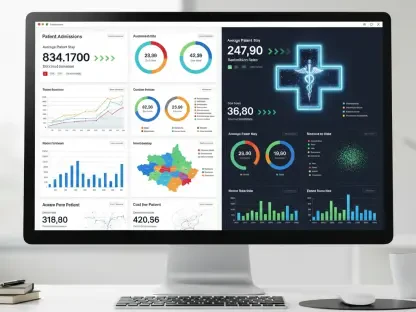The Current Landscape of Healthcare Payment Models
The healthcare industry stands at a pivotal moment, grappling with a staggering challenge: escalating costs that outpace inflation, with total U.S. healthcare spending projected to reach $6.8 trillion by the end of this decade. At the heart of this crisis lie payment models, the mechanisms that dictate how care is funded and delivered, influencing everything from provider decisions to patient outcomes. Today, fee-for-service remains dominant, rewarding volume over value by compensating providers for each procedure or visit, often leading to unnecessary interventions. Alongside this, voluntary models introduced by the Center for Medicare & Medicaid Innovation (CMMI) aim to test alternative approaches, while commercial insurance frameworks continue to prioritize spending-driven profitability, creating a complex web of incentives and inefficiencies.
These payment structures play a critical role in shaping healthcare delivery, as they directly affect provider behavior by incentivizing certain practices over others, often at the expense of long-term patient health. For instance, fee-for-service can drive overutilization, while newer models like accountable care organizations seek to align provider goals with patient well-being. Key stakeholders, including CMS, commercial insurers, employers, and providers, navigate this landscape under the influence of regulations such as the Affordable Care Act, which has pushed for innovation but also added layers of complexity through compliance demands. The interplay of these forces determines access to care, cost distribution, and overall system sustainability.
Technology has emerged as a vital enabler in this space, supporting payment model evolution through advanced data tracking and analytics. Electronic health records and interoperable systems allow for real-time monitoring of costs and outcomes, providing the foundation for more transparent and efficient reimbursement mechanisms. As digital tools continue to mature, they offer the potential to bridge gaps between payers and providers, ensuring that payment models are not just reactive but predictive, tailored to the needs of diverse populations.
Key Trends and Innovations in Payment Models
Emerging Shifts Toward Value-Based Care
A seismic shift is underway in healthcare, with value-based care gaining traction as a model that prioritizes patient outcomes over the sheer volume of services rendered. This approach seeks to realign incentives by rewarding providers for quality and efficiency, rather than the number of tests or treatments performed. Innovations such as bundled payments, which cover an entire episode of care, and accountable care organizations, which share savings and risks among providers, are reshaping how healthcare is financed and delivered, fostering collaboration across the care continuum.
Beyond structural changes, consumer empowerment is becoming a cornerstone of this transformation, driven by greater cost transparency and active employer involvement. Patients are increasingly equipped with tools to understand pricing, enabling informed decisions, while employers push for proactive health behaviors through wellness programs and tailored benefits. These efforts aim to reduce long-term costs by addressing health issues before they escalate, marking a departure from traditional reactive care models.
Supporting these shifts are technological advancements, particularly in health data analytics, which allow for precise outcome measurement and personalized care strategies. Machine learning algorithms can predict patient risks, while integrated platforms provide a holistic view of health metrics, enabling payers and providers to fine-tune interventions. This data-driven approach not only enhances care quality but also builds trust by aligning payment with tangible results, setting the stage for broader adoption of value-based principles.
Market Insights and Growth Projections
Current data reveals a steady rise in the adoption of value-based payment models, with CMS reporting that over 30% of Medicare payments are now tied to alternative structures, a figure expected to grow significantly by 2030. Studies indicate that these models have already reduced costs in certain areas, such as hospital readmissions, by up to 15%, while improving quality metrics like patient satisfaction scores. These early successes underscore the potential for widespread impact if barriers to implementation are addressed.
Looking ahead, forecasts suggest an expansion of mandatory payment models, with projections indicating that by 2030, nearly half of all healthcare payments could be tied to value-based frameworks. Long-term investment strategies are also anticipated, as payers and providers commit to multi-year initiatives focused on population health. Performance indicators, including reduced healthcare utilization rates and enhanced patient engagement, will serve as critical benchmarks, providing measurable evidence of success or areas needing adjustment.
Market dynamics are poised for further evolution, driven by payer motivation to lower costs and delegate risk to providers through shared accountability agreements. This shift could redefine competitive landscapes, encouraging smaller providers to form alliances and larger systems to innovate at scale. As financial risks are redistributed, the focus on preventive care and cost control is likely to intensify, creating a more balanced and sustainable ecosystem over the coming years.
Challenges in Transforming Payment Models
Systemic flaws in existing payment structures pose significant hurdles to meaningful reform, with commercial insurance often perpetuating misaligned incentives. Profitability in this sector is frequently tied to a percentage of spending, encouraging higher expenditures rather than cost-saving measures or improved health outcomes. This fundamental disconnect undermines efforts to prioritize value, as financial gains are linked to volume rather than efficiency or patient well-being.
Further complicating the transition are the limitations of voluntary CMMI models, which often operate on short-term horizons of three to five years. Such brevity discourages providers from making substantial investments in infrastructure or process changes, as the return on investment remains uncertain beyond the model’s duration. Additionally, operational challenges arise when scaling pilot programs to broader adoption, compounded by cultural resistance among providers accustomed to reactive rather than preventive care approaches.
Potential solutions lie in restructuring incentives to reward outcomes over spending, extending the duration of innovative models to ensure sustainability, and leveraging payer influence to drive systemic change. By aligning financial rewards with long-term health improvements, stakeholders can foster a commitment to value-based principles. Encouraging collaboration across sectors and investing in change management could also ease cultural shifts, paving the way for more proactive and scalable healthcare delivery systems.
Regulatory Frameworks Impacting Payment Models
The regulatory environment profoundly shapes payment model innovation, with provisions under the Affordable Care Act and CMMI guidelines setting the tone for experimentation and accountability. These frameworks have spurred the development of alternative payment structures, yet they also impose documentation and compliance requirements, particularly in home and community care settings. Such mandates often create administrative burdens that detract from direct patient care, slowing the pace of reform.
These regulatory burdens contribute to inefficiencies, limiting access to care in non-traditional settings where flexibility is crucial. Strict rules about who can provide services and under what conditions hinder the ability to deliver timely interventions, especially for vulnerable populations reliant on home-based support. Balancing the need for oversight with operational freedom remains a persistent challenge, as overly rigid standards can stifle innovation and adaptability.
Looking toward 2030, regulatory reforms could play a pivotal role in supporting value-based care by reducing administrative obstacles and streamlining compliance processes. Simplifying documentation requirements and fostering policies that encourage experimentation with payment models may unlock new opportunities for efficiency. Aligning federal and state regulations to prioritize outcomes over procedural adherence could further enhance access, ensuring that regulations serve as enablers rather than barriers to progress.
The Future of Payment Models in Healthcare
By 2030, payment models are expected to undergo a profound transformation, with mandatory participation becoming a cornerstone of reform to ensure widespread adoption and impact. Long-term sustainability will likely take precedence, with incentives increasingly tied to measurable outcomes rather than short-term metrics. This evolution could see a healthcare system where financial structures consistently reward prevention and quality, fundamentally altering how care is prioritized and funded.
Emerging technologies, such as integrated health data systems, are set to enhance this future by improving outcome measurement and empowering consumers with actionable insights. Seamless data sharing across platforms could enable real-time adjustments to care plans, while patient-facing tools promote engagement and accountability. These advancements promise to bridge gaps between stakeholders, creating a more cohesive and responsive healthcare ecosystem.
Disruptors, including employer-driven health plans and new market entrants advocating for transparency, may further accelerate change by challenging traditional payer-provider dynamics. Global economic conditions, evolving regulatory landscapes, and societal trends toward prevention will also shape growth, pushing the industry to adapt to broader demands. As these forces converge, the potential for a more equitable and efficient system emerges, driven by innovative payment models that align with the needs of patients and communities.
Conclusion and Strategic Recommendations
Reflecting on the discussions and analyses, it has become clear that payment models hold immense power in steering healthcare toward a sustainable, value-based future. The journey reveals persistent challenges, from misaligned incentives to regulatory constraints, yet also illuminates promising innovations and trends that point to transformative potential. The insights gathered underscore that systemic reform is not just necessary but achievable through deliberate and collaborative action.
Moving forward, stakeholders must prioritize mandating innovative payment models to ensure broad participation and impact, while reforming commercial insurance incentives to focus on value over volume. Easing regulatory constraints, particularly in home and community care, emerges as a critical step to enhance access and efficiency. Furthermore, investing in consumer transparency tools and cultural initiatives to promote prevention stands out as essential for long-term success.
Collaboration among payers, providers, employers, and regulators is identified as the linchpin for driving these changes, with a shared commitment to improved outcome measurement tools paving the way for accountability. By aligning efforts around these strategic priorities, the healthcare industry can build a foundation for systemic improvement, ultimately delivering better patient outcomes and a more resilient system for future generations.









